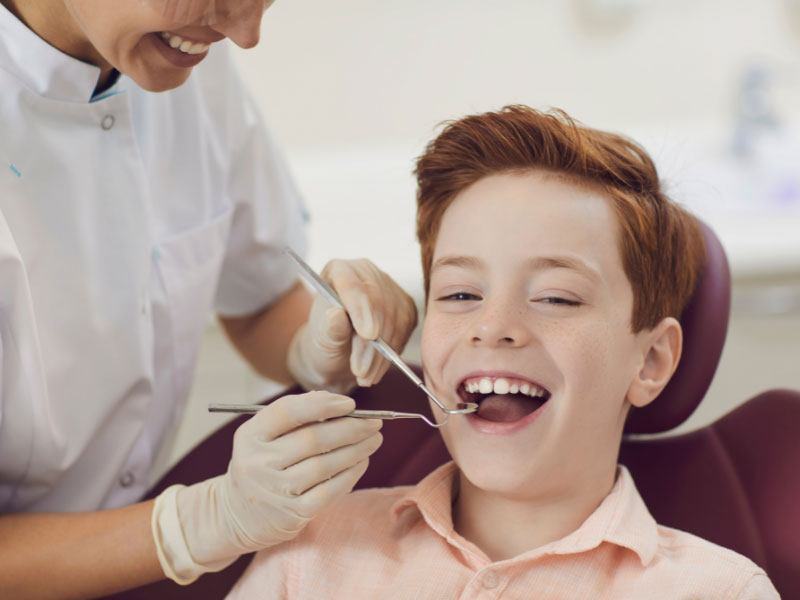Why Children Should See an Orthodontist

Has your child been referred to an orthodontist at an early age and it has left you wondering why? There are multiple reasons why it is important to visit an orthodontist when your kids are young. Orthodontists recommend kids as young as 6 years old have an evaluation. An evaluation helps determine if your child needs early intervention or if they need to watch their development and growth, which helps them determine what type of treatment they may need and when in the long run.
The American Association of Orthodontics (AAO) recommends that your child’s first checkup be when an orthodontic problem is first recognized but no later than 7 years of age. By then they have enough permanent teeth for the orthodontist to evaluate the developing teeth and jaws, which can provide a wealth of information.
Here are some reasons for early intervention:
- Crowded or crooked teeth
- Spaces between teeth
- Extra teeth or missing teeth
- Difficulty eating, chewing, or biting
- Protruding/overjet of front teeth
- Open bite – front teeth don’t touch
- Deep overbite – lower teeth bite into palate
- Underbite – lower front teeth in front of upper teeth
When kids have narrow palates, permanent teeth may come in crowded. Sometimes early treatment can just be an expander to expand the upper palate (roof of the mouth) to create space for teeth to erupt. Expanders may also be used to correct crossbite and breathing problems. A crossbite is when you close your mouth and some of your upper teeth are on the inside of your lower teeth rather than the outside. If your child has a narrow or deep upper jaw, it may be difficult for them to breathe out of their nose, increasing mouth breathing which can cause unhealthy inhalation of bacteria, dry mouth, and potential bad breath.
The interceptive treatment makes it easier to address problems like crowding. Crowding of the teeth makes it harder to maintain good oral hygiene. Some dental issues are inherited, come from accidents or dental disease. With crowding it is easy to miss plaque in the tight and crooked teeth, the contacts between the teeth may be tight making it more difficult to flossing and get the toothbrush properly around all the teeth. Before braces get placed, brushing and flossing needs to be good no matter how difficult it may be. It will be harder to maintain oral hygiene with braces, the orthodontist makes sure you can take care of your teeth before braces come on. Otherwise, there are higher risks for cavities, which will require you to get fillings. Gingivitis is a form of gum disease, the gums get irritated, red, and swollen. Decalcification is when the remineralization process of a tooth is disrupted, also called white spots. Typically it happens with poor oral hygiene and sugary foods, drinks like soda, juices, sweet tea and are usually permanent.
A study by the American Journal of Orthodontics and Dentofacial Orthopedics found that in the United States, 15% of children between the ages of 12 and 15 have protruding front teeth or buck teeth. It is when the front teeth stick out from under the upper lip and sometimes cover the lower lip. Genetics and habits can play a role in having protruding teeth. Sometimes it can be caused by imbalanced jaw size, meaning a lower jaw is either small or set too far back. Once your child’s permanent teeth start coming in, it’s very important to make sure they are not sucking on pacifiers or their thumb/fingers. It can cause the teeth to grow out and disrupt their natural growth. Some issues that can come up are chewing and increased risk for dental trauma. It is hard to bite and chew food. With teeth sticking out they are more likely to get chipped or knocked out. The lips serve as a defense for the teeth and if the teeth are protruding they are more accessible to get damaged in a fall or hit.
If early intervention is necessary, there is a higher chance of improving the growth of your child’s jaw and face and can avoid potential problems in the future. Braces on children early on may help avoid jaw surgery or tooth extractions later on. Early orthodontic treatment can be less expensive, less painful, and less time-consuming in the long run. Kids’ bones are more malleable and easier to expand the jaw to make more room for their teeth.
Different treatment plans can fit your child’s needs. The best thing you can do is start introducing them to dental and orthodontic offices, that way they are comfortable in that type of atmosphere. It may be beneficial to intervene sooner than later. Getting a new patient exam and having a treatment consultation would be the first thing to do. Photos will be taken for the orthodontist to look at the teeth and jaw and plan a treatment plan or it may be that no treatment is needed at this time and your child would be seen back for development checks to continue watching their growth.
Are you looking for a Waterbury orthodontist? Look no further! Contact us today for a free consultation and find out how we can help your smile be the best it can be.



Please login to publish a comment.
Comments (0)